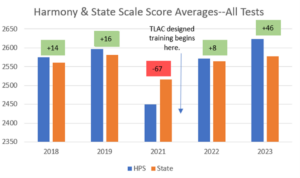12.13.23Lasting Change at Scale: Lessons From Our Work With Harmony Public Schools
 42,000 students and counting…
42,000 students and counting…
In October, our Consulting & Partnerships team completed a 30-month partnership (March 2021-September 2023) with Texas’ largest charter school network, Harmony Public Schools. Our role was to help the network refine its vision for instructional leadership, then build training and systems to study progress across its 55 (now 60) schools. Dan Cotton and Dillon Fisher, who worked on the project, shared this reflection on some of the challenges of making change at scale. They’ll share further reflections in the coming weeks.
Introduction: A High Difficulty Dive
It’s worth observing how high the level of difficulty Harmony’s dive is: implementing anything across 300+ leaders, 42,000 students, and 60 campuses spread across the state of Texas would be challenging. Improving lesson preparation–one of their “Core 4”–at that scale is truly ambitious. By number of students served, Harmony would rank in the top 150 school districts in the US.
So besides supporting the academic achievement of 42,000 students, our partnership was a chance for us to answer a key question large school systems that seek to deliver an outstanding education for all of their students must solve: What does it take to drive substantive, durable changes in adult behavior across school systems of that size resulting in sustained student growth and achievement?
The data indicate we’re on the right track to answering this question.
In 2023, Harmony made its largest jump in the last 5 years in average scaled scores on state assessments and significantly outpaced the state average:

Schools are such complex organizations that growth in student achievement in a single school or large district is always the result of multiple factors. At the center of Harmony’s vision for instructional leadership is its Core 4–the key capacities all leaders need to develop to ensure effective teaching in every classroom:
- Coaching Lesson Preparation
- Observation-Feedback
- Student Work Analysis
- Practice-Based Professional Development
Harmony’s senior leaders identify their leaders’ increasing effectiveness with executing the Core 4 as a key driver of their results.
Why Lesson Prep?
In the past 5 years, schools across the US (and throughout the world) have recognized the importance of High Quality Instructional Materials–putting rigorous, grade level content in front of kids–as a necessary condition for equity and academic achievement. But even the highest quality materials don’t teach themselves. To achieve these outcomes, they need to be coupled with effective instruction.
In order to ensure Harmony could best support teachers in this task, we chose to prioritize Lesson Preparation. Specifically, we sought to support Harmony in determining how to develop and scale teachers’ capacity to engage in effective lesson preparation: Could we help leaders get clear on a process of lesson preparation and support their teachers in using it so that it resulted in students engaging more deeply and mastering more rigorous lessons?
Here’s what we’ve learned about implementing Lesson Preparation (and other major initiatives) at scale:
- Define and communicate a clear expectation for leaders and teachers of the vision for effective lesson preparation. This included beginning with videos of exemplary teaching and the accompanying lesson preparation the teacher did that produced the excellence observed in the video.
- Create a clear, coaching protocol for leaders to use to support teachers in building capacity for independent lesson preparation. We provided an initial protocol and, working alongside Harmony colleagues, then studied its implementation across Harmony, revising it together to meet the challenges and opportunities of Harmony’s specific context.
- Provide network leaders with a window into what coaching and teaching–both preparation and execution–look like in order to identify trends and respond. We built a google-form based system to collect coaching video, teaching video and leader and teacher preparation documents from across Harmony’s 55 campuses. Importantly–it was easy for leaders to submit their work and easy for the network (and us) to pull from to study trends.
- Develop curriculum specific Lesson Delivery Models so that leaders and teachers have a shared understanding for how lessons unfold. We worked alongside Harmony’s Curriculum Directors to help them define the vision for how a lesson should unfold in their particular content area, with their curriculum, then collect video and build PD/training to support understanding and implementation of the vision.
- Sustain a multi-year commitment to internal capacity building at all levels of the organization. Harmony knew that a single year of training investment does not move a system to mastery. They have named and are continuing to advance a 6 year commitment to this work.
To see examples and learn more about each of these learnings, click the links below to the other posts in this series:
